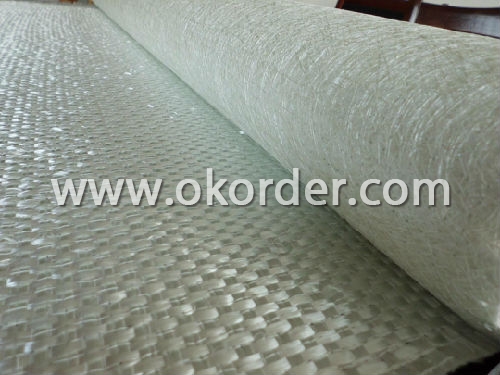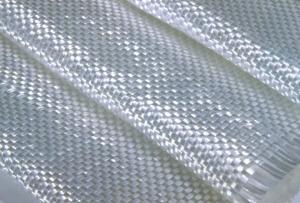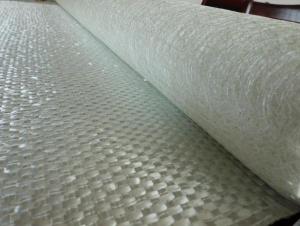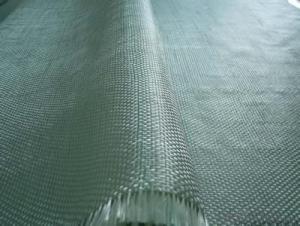Fiberglass Biaxial Fabric
- Loading Port:
- China Main Port
- Payment Terms:
- TT or LC
- Min Order Qty:
- 2Ton kg
- Supply Capability:
- 100Ton Per Month kg/month
OKorder Service Pledge
OKorder Financial Service
You Might Also Like
Application of Fiberglass Biaxial Fabric
Model: 100-200KN
Tensile Strength(KN/M): warp direction: aa100
Elongation: aa4%
Mesh Size: 25.4*25.4mm
Introduction of Fiberglass Biaxial Fabric
fiberglass biaxial fabric have excellent designable Character and great combination character with mat.
fiberglass geogrid is a kind of excellent geosynthetics for the reinforcement of road surface and basement.
Biaxial and multiaxial fabric consists of two or more layers roving fiberglass at different orientations (0, 90, +45, -45), which are stitched together by fine polymer yarn. Standard configurations include biaxial (0,90), (+45,-45), traxial(0,+45,-45) or (90, +45, -45) and multiaxial (0,90,+45,-45).Because of its excellent designable ability and great combination character with mat perfectly, it is omnipotent with any complex FRP/Composites products needing reinforcement. For instance, wind turbine blade,shipbuilding industry, auto industry, sports apparatus, medical apparatus, the furniture, etc.
Specification of Fiberglass Biaxial Fabric
| STYLE | MASS | MASS | LENGTH | WIDTHcm | WEIGHT | RESIN COMPATIBILITY |
EB450 (0/90) | 450 | 13.3 | 110 | 100 | 49.5 | UP or Epoxy resin |
EB600(0/90) | 600 | 17.7 | 80 | 100 | 48.0 | UP or Epoxy resin |
EB700(0/90) | 700 | 20.6 | 70 | 100 | 49.0 | UP or Epoxy resin |
EB800(0/90) | 800 | 23.6 | 60 | 100 | 48.0 | UP or Epoxy resin |
EB950(0/90) | 950 | 26.5 | 50 | 100 | 47.5 | UP or Epoxy resin |
EB1000(0/90) | 1000 | 29.5 | 50 | 100 | 50.0 | UP or Epoxy resin |
EB1200(0/90) | 1200 | 35.4 | 40 | 100 | 48 | UP or Epoxy resin |
EU400(45/-45) | 400 | 11.8 | 100 | 127 | 50.8 | UP or Epoxy resin |
EU600(45/-45) | 600 | 17.7 | 65 | 127 | 49.5 | UP or Epoxy resin |
ETW750(45/-45/90) | 750 | 22.1 | 50 | 127 | 47.6 | UP or Epoxy resin |
ETL800(0/45/-45) | 800 | 23.6 | 50 | 127 | 50.8 | UP or Epoxy resin |
EMU900(0/45/90/-45) | 900 | 26.5 | 50 | 127 | 57.2 | UP or Epoxy resin |
Note of Fiberglass Biaxial Fabric
Normally the width is 127cm,it can be cut to any width according to the customers requirements. We can also combinate the chopped strand mat.
Packing of Fiberglass Biaxial Fabric:
Each roll covered by polyethylene plastic bag,then placed into cardboard box. Cardboard box size: 1000mm×260mm×260mm,also can be set on pallet, Each pallet vertical stack 16 cardboard boxes which sizing: 1120mm×1120mm×1150mm.
Storage of Fiberglass Biaxial Fabric:
Product shall be placed under dryness condition and shall not be opened the covering membrane until applying.


- Q:What are the typical applications of fiberglass fabrics?
- Fiberglass fabrics have a wide range of applications due to their unique properties and versatility. Some of the typical applications of fiberglass fabrics include: 1. Construction: Fiberglass fabrics are widely used in the construction industry for reinforcing concrete structures. They are used as a substitute for steel reinforcement in applications such as walls, beams, and columns. Fiberglass fabrics provide high strength, corrosion resistance, and durability, making them suitable for various construction projects. 2. Automotive industry: Fiberglass fabrics find application in the automotive industry for manufacturing lightweight and high-performance parts. They are used to reinforce body panels, interior components, and structural parts. Fiberglass fabrics offer excellent strength-to-weight ratio and impact resistance, making them ideal for improving fuel efficiency and reducing vehicle weight. 3. Aerospace and aviation: Fiberglass fabrics are used in the aerospace and aviation industry for manufacturing aircraft components. They are used in the construction of aircraft wings, fuselage panels, interior structures, and fairings. Fiberglass fabrics provide high strength, stiffness, and resistance to extreme temperatures, making them suitable for demanding aerospace applications. 4. Marine industry: Fiberglass fabrics are extensively used in the marine industry for boat and yacht construction. They are used to build hulls, decks, bulkheads, and other structural components. Fiberglass fabrics offer excellent resistance to water, chemicals, and UV radiation, making them ideal for marine applications. 5. Sports and recreation: Fiberglass fabrics are commonly used in the sports and recreation industry for manufacturing various equipment and products. They are used to create sporting goods like golf clubs, fishing rods, archery bows, and surfboards. Fiberglass fabrics provide high strength, flexibility, and impact resistance, making them suitable for demanding sports applications. 6. Electrical insulation: Fiberglass fabrics find application in electrical insulation due to their non-conductive properties. They are used as insulating materials in electrical components like circuit boards, transformers, and electrical motors. Fiberglass fabrics offer excellent thermal stability, electrical insulation, and flame retardancy, making them ideal for electrical applications. Overall, fiberglass fabrics are widely used in various industries due to their exceptional properties such as high strength, durability, corrosion resistance, lightweight, and flexibility. These fabrics provide excellent solutions for diverse applications ranging from construction and automotive to aerospace and sports.
- Q:What are the different finishing options available for fiberglass fabric?
- Fiberglass fabric offers various finishing options, each with distinct properties and uses. One prevalent choice involves applying a resin or polymer coating to the fabric, which boosts its strength and durability, rendering it more tear and abrasion resistant. This coating also offers additional safeguards against chemicals, UV rays, and moisture. Another option is to laminate the fiberglass fabric with different materials, like foam or felt, resulting in a composite fabric. This combination incorporates the fiberglass's strength and flexibility with the unique properties of the laminated material. This proves beneficial for applications requiring insulation, cushioning, or sound absorption. Furthermore, fiberglass fabric can undergo treatment with a fire retardant finish. This treatment reduces the fabric's flammability, making it suitable for environments where fire safety is a concern. Some fiberglass fabrics are also available with a silicone or PTFE (polytetrafluoroethylene) finish. These finishes enhance the fabric's heat resistance and provide a non-stick surface that is easy to clean. Consequently, they are ideal for insulation blankets, conveyor belts, or release liners. To summarize, fiberglass fabric can be finished with resin or polymer coatings, lamination with other materials, fire retardant treatments, or silicone or PTFE finishes. The choice of finishing option depends on the specific requirements of the application, such as strength, durability, heat resistance, or fire safety.
- Q:Is high strength fiberglass cloth the same as high silica fiberglass cloth?
- The high silica glass fiber cloth is one of the high strength fiber cloth, but it is also the most common and most common one.
- Q:Are fiberglass fabrics resistant to chemicals?
- Yes, fiberglass fabrics are generally resistant to chemicals.
- Q:Can fiberglass fabric be used for insulation in cryogenic systems?
- Yes, fiberglass fabric can be used for insulation in cryogenic systems.
- Q:Can fiberglass fabric be used for reinforcement in construction materials?
- Yes, fiberglass fabric can be used for reinforcement in construction materials. Fiberglass is a strong and durable material that is commonly used in construction for its reinforcement properties. It is commonly used in applications such as concrete reinforcement, roofing materials, and insulation. Fiberglass fabric is lightweight, corrosion-resistant, and has high tensile strength, making it an ideal choice for reinforcing various construction materials. It helps to increase the strength and durability of the materials, improving their resistance to cracking, impact, and other forms of damage. Additionally, fiberglass fabric is easy to work with and can be easily molded or shaped to fit different construction needs. Overall, fiberglass fabric is a reliable and versatile material that is widely used for reinforcement in construction materials.
- Q:What are the different thicknesses of fiberglass fabric used in insulation?
- Depending on the specific application and desired level of thermal resistance, the thicknesses of fiberglass fabric used in insulation can vary. Manufacturers and regions may offer varying thickness options, typically ranging from 1 inch (25mm) to 4 inches (100mm) or more. The chosen thickness depends on factors such as the desired insulation R-value, available installation space, and specific project requirements. Thicker fiberglass fabric provides higher thermal resistance, improving insulation performance and reducing heat transfer and energy loss. However, thicker insulation requires more installation space and may be more expensive. Therefore, it is important to carefully consider project needs and limitations when determining the appropriate thickness of fiberglass fabric for insulation.
- Q:Are fiberglass fabrics resistant to static electricity?
- Generally, fiberglass fabrics exhibit resistance to static electricity. This is due to the fact that fiberglass is a non-conductive substance, preventing the flow of electrical current. Static electricity occurs when two materials with differing electrical charges make contact and then separate, leading to an imbalance of electrons. As fiberglass is non-conductive, it does not easily accumulate or retain static charge. Consequently, fiberglass fabrics have a lower tendency to generate or retain static electricity compared to conductive materials or those with a higher level of electrical conductivity. However, it is important to acknowledge that the specific characteristics of the fiberglass fabric can vary based on its composition and any additional treatments or coatings it may possess.
- Q:What are the different fiberglass fabric coatings for chemical resistance?
- The market offers various fiberglass fabric coatings, each with excellent chemical resistance. Some commonly utilized coatings include: 1. PVC Coating: PVC coating exhibits favorable chemical resistance to acids, alkalis, and solvents. It finds widespread use in applications necessitating protection against corrosive chemicals. 2. PU Coating: PU coating boasts exceptional resistance to abrasion, chemicals, and oils. It is frequently employed in applications where the fabric must endure harsh chemical environments. 3. Fluoropolymer Coating: Fluoropolymer coatings, like PTFE and FEP, provide outstanding chemical resistance to corrosive chemicals, acids, and solvents. These coatings find extensive usage in industries such as chemical processing, pharmaceuticals, and food processing. 4. Silicone Coating: Silicone coating offers commendable resistance to chemicals, oils, and extreme temperatures. It is commonly utilized in applications requiring both chemical resistance and high-temperature resistance. 5. Neoprene Coating: Neoprene coating delivers excellent resistance to a wide array of chemicals, oils, and solvents. It is frequently employed in applications where the fabric must withstand exposure to aggressive chemicals. It is crucial to consider the specific chemical environment and the desired level of resistance when selecting a coating. Consulting a technical expert or coating manufacturer is recommended to identify the most suitable fiberglass fabric coating for a particular chemical resistance application.
- Q:How does fiberglass fabric perform in flexibility?
- Known for its excellent flexibility, fiberglass fabric is a lightweight and pliable material that easily takes on various shapes and forms. This flexibility stems from the composition of fiberglass itself, which consists of thin glass fibers woven together. These fibers possess high flexibility, allowing them to bend and flex without any risk of breaking or compromising their structural integrity. Consequently, fiberglass fabric proves to be a versatile material suitable for a wide range of applications necessitating flexibility. Moreover, fiberglass fabric can also be combined with other materials to further enhance its flexibility. Overall, fiberglass fabric delivers exceptional performance in terms of flexibility, making it a favored choice in industries like automotive, aerospace, and construction.
1. Manufacturer Overview |
|
|---|---|
| Location | Shanghai,China |
| Year Established | 2006 |
| Annual Output Value | Above US$20 Million |
| Main Markets | Mid East;Western Europe;North America:South American |
| Company Certifications | |
2. Manufacturer Certificates |
|
|---|---|
| a) Certification Name | |
| Range | |
| Reference | |
| Validity Period | |
3. Manufacturer Capability |
|
|---|---|
| a)Trade Capacity | |
| Nearest Port | Shanghai |
| Export Percentage | 70% |
| No.of Employees in Trade Department | 200 People |
| Language Spoken: | English;Chinese |
| b)Factory Information | |
| Factory Size: | Above 400,000 square meters |
| No. of Production Lines | Above 15 |
| Contract Manufacturing | Average |
| Product Price Range | OEM Service Offered;Design Service Offered |
Send your message to us
Fiberglass Biaxial Fabric
- Loading Port:
- China Main Port
- Payment Terms:
- TT or LC
- Min Order Qty:
- 2Ton kg
- Supply Capability:
- 100Ton Per Month kg/month
OKorder Service Pledge
OKorder Financial Service
Similar products
New products
Hot products
Hot Searches
Related keywords




























